Da Ci’en Temple, originally called Wulou Temple, was built in 589AD of Sui Dynasty, which is a world-famous major Buddhist temple. In 648AD of Tang Dynasty it was enlarged on scale and called Da Ci’en Temple (Temple of Mercy and Kindness). The Hierarch Xuan Zang, as the first abbot of Da Ci'en Temple, supervised the building of the Big Wild Goose Pagoda for the storage’s sake of a number of sutra and sliver brought with his return from India (the cradle of Buddhism). Ever since the completion of the Pagoda, there Xuan Zang started to translate Sanskrit in sutras into Chinese. With Xuan Zang’s creation of the Dharma-phpect Sect there, Da Ci’en Temple was regarded as the birthplace of the Dharma- phpect Sect by followers from both China and Japan.
In China, many temples house treasures and artifacts, but the sheer quantity and quality of treasures in the Famen Temple are rare. Situated in Famen Town of Fufeng County, about 120 kilometers (about 74.57 miles) west of Xian, Famen Temple is renowned for storing the veritable Finger Bone of he Sakyamuni Buddha.
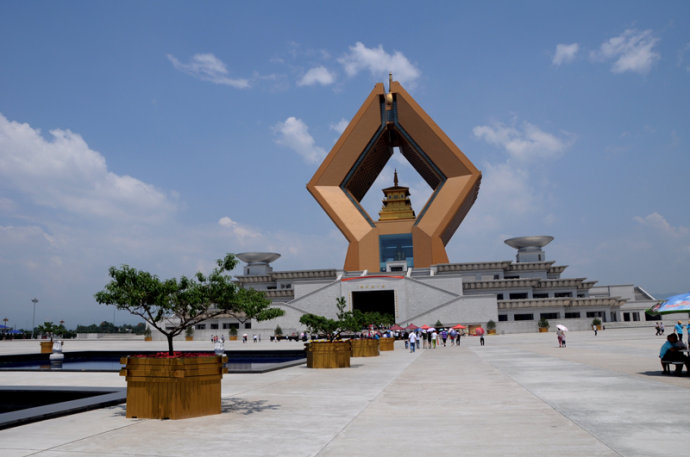
Famen Temple was established in the Eastern Han Dynasty (25--220), for carrying forward Buddhism. The most representative structures in the temple are the Famen Temple Pagoda and Famen Temple Museum.
At the center of the temple is the 13-tiered octagonal pagoda under which it is said, a sliver of the finger bone of Sakyamuni buried. In 1981, subsidence of the pagoda led to reconstruction, during which, an Underground Palace was discovered unexpectedly in 1987. Many royal treasures and jewelry were found here-more than 2,000 pieces surrounded the Tang mandala (geometric designs, usually circular, symbolizing the universe). The most precious one is the veritable Finger Bone of the Sakyamuni Buddha. At present, this is the biggest Buddhist underground palace so far discovered. From the grand architectural style, it is said to have been established in the Tang Dynasty (618-907). But why, and how such precious treasures were stored under the pagoda. Tracing back to a most flourishing time in Chinese history, formerly, Famen Temple was the royal temple during the Sui Dynasty (581-618) and Tang Dynasty. Emperors in Sui and Tang believed that enshrining and worshiping the bone of Sakyamuni would bring riches and peace to the land and its people. So an offering of treasure to the finger bone was made, it was housed in the Underground Palace.
Due to the appropriate collection and further expounding of the cultural connotations of the treasures to the public, the Famen Temple Museum was established in 1987, which includes most of the precious treasures from the Tang Dynasty removed from Underground Palace, including gold and silverware, colored glaze ware, porcelain and silks. Owing to more and more tourists and their curiosity to the relics, two new exhibition halls were established in 2000. The exhibition area expanded from 500 square meters to 3,000 square meters, which well caters for the interest of tourists.
Nowadays, Famen Temple, which is the most famous Buddhist temple, plays a sovereign role in Chinese Buddhism, and appeals to tourists from all over the world.
Address: Fufeng County, Shaanxi Province
Known as the Buddhist Holy Land, Caotang Temple lies about 30 kilometers (25 miles) southwest of Xian, in Caotangying Village of Huxian County. Initially built in 401, the temple became a sacred place where the Buddhist master, Kumarajiva (one of the four Buddhist translators), translated Buddhist scriptures. The temple was a thatch-roofed house, so it got the name of Caotang Temple, meaning Straw Hut Temple.
Kumarajiva - A famous Buddhist master, became a monk at the age of seven. Due to his intelligence and diligence, he mastered the sprit of the Buddhism very well. He led 3,000 Buddhist followers to translate sutras from Sanskrit to Chinese. Instead of metaphrase, he used free translation, which made the scriptures easy to understand.
Features inside the temple:
Kumarajiva Dagoba - Precious Art
Baohui Buddhist Master Preaching Inscription - The real script of the famous calligraphy Liu Gongquan.
The Mist of Caotang Temple - One of the eight famous scenic features in Shaanxi Province A well inside the temple occasionally emits gusts of mist. The legend is that there is a piece of stone on one side, halfway down the well, and whenever there is a snake lying on the stone, the mist comes out, and travels over the countryside. The real cause of the mist, however, might be geothermal vapor, which, once out of the well, gets mixed with the smoke of incense over the temple. Later an elegant pavilion has been built over the well and was named as 'the Misty Well'.
Address: Huxian County, Xi’an
Xiangji Temple is situated in Chang'an County, about 17.5 kilometers (12 miles) to the south of Xian City. It was built in honor of the noted Buddhist monk Shandao, one of the initiators of a branch of Buddhism, Pure Land Buddhism, by his disciple Huai Yun after his master's death. Huai Yun named the temple 'xiangji', heaped fragrance, to suggest his master was holy as the Xiangji Buddha, an ancient Indian Buddha. Many Pure Land Buddhists, who believe in the purification of the soul through faith, began conducting activities at the temple, which led to it being considered the center and cradle of the Pure Land sect.
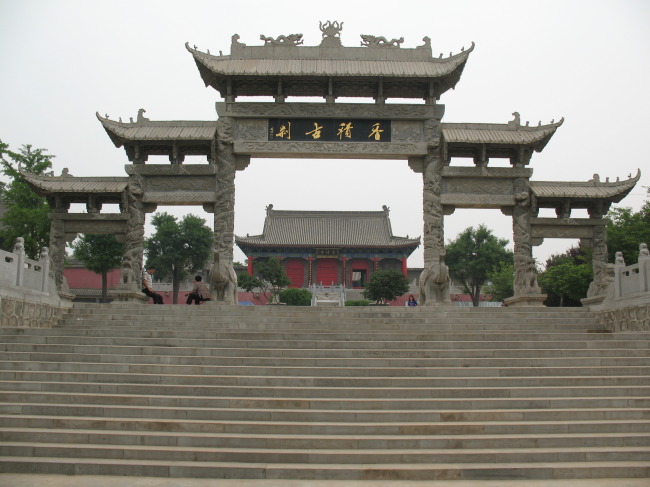
Two pagodas stand in Xiangji Temple. The larger pagoda, named Shandao Pagoda, is 33 meters (108 feet) tall, and was built in 680, during the Tang Dynasty (618-907). The top two stories of the pagoda have worn away during its 1300 years of history, leaving a remaining eleven stories. Its flank is stenciled with exquisitely engraved half-naked Buddha and strong pieces of script. To the east stands the pagoda's smaller counterpart, a brick pagoda built to commemorate another of Shandao's pious disciples, Jingye. Surrounding these two pagodas is a vista that is beautiful and tranquil. The renowned landscape poet Wang Wei of the Tang Dynasty visited the Temple and composed a poem to praise its charms.
The Xiangji Temple had its heyday during the Tang Dynasty. Emperors like Gaozong and Zhongzong, and the Empress Wu Zetian all visited the site and had cults started in their honor. Today, countless tourists come from across China and the world to sightsee and reflect at the temple.
Green Dragon Temple is a famous Buddhist Temple from the Tang Dynasty (618-907). When it was built in 582, it was called Linggan Temple (Temple of Inspiration) and then renamed to its present one in 711. When Buddhism was prevalent during the Tang Dynasty, some Japanese monks were sent to China to study Buddhism. Six of them studied at Green Dragon Temple, and this led to a flourishing period of the temple in the ninth century.
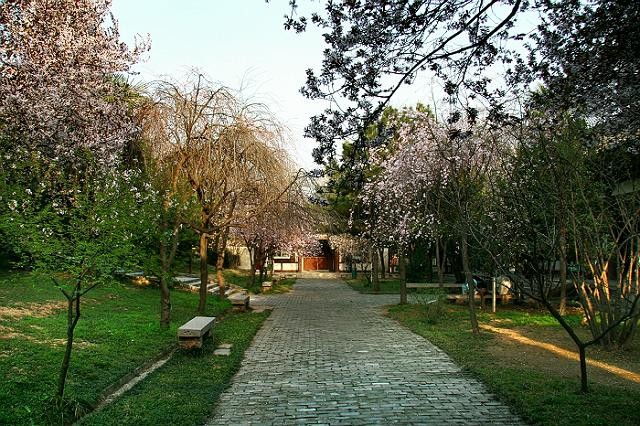
Kukai, the most learned of the six monks, made great progress in learning Buddhist sutras, Sanskrit, poems and Chinese calligraphy. After his return to Japan in 806, he advocated the building of a Vagra Temple (Vagra means Buddhist Warrior Attendant) and founded the Zhenyan Sect (the True Word Sect). He is highly honored by both Japanese and Chinese, and in 1982 Kukai Monument was constructed inside the Green Dragon Temple.
For uncertain reasons the Green Dragon Temple which had no fortune, like other ancient temples was destroyed. This was perhaps during the Northern Song Dynasty (960-1127).
The present temple was reconstructed in 1963. Memorial halls for the earlier monks and exhibition halls with some excavations displayed are all built in the Tang architectural style.
Green Dragon Temple is a place where the cherry blossoms can be enjoyed. Every year during May and June, an endless stream, of tourists comes to appreciate its beauty.
The Great Mosque in Xian is one of the oldest, largest and best-preserved Islamic mosques in China and its location is northwest of the Drum Tower (Gu Lou) on Huajue Lane.
According to historical records engraved on a stone tablet inside, this mosque was built in 742 during the Tang Dynasty (618-907). This was a result of Islam being introduced into Northwest China by Arab merchants and travelers from Persia and Afghanistan during the mid-7th century when some of them settled down in China and married women of Han Nationality. Their descendants became Muslim of today. The Muslim played an important role in the unifications of China during the Yuan and Ming Dynasties. Hence, other mosques were also built to honor them.
In Xian, it is really well worth a trip to see the Great Mosque, not only for its centuries-old history but also for its particular design of mixed architecture - traditional Muslim and Chinese styles.
Occupying an area of over 12,000 squaremeters, the Great Mosque is divided into four courtyards, 250 meters long and 47 meters wide with a well-arranged layout. Landscaped with gardens, the further one strolls into its interior, the more serene one feels.
The first courtyard contains an elaborate wooden arch nine meters high covered with glazed tiles that dates back to the 17th century. In the center of the second courtyard, a stone arch stands with two steles on both sides. On one stele is the script of a famous calligrapher named Mi Fu of the Song Dynasty; the other is from Dong Qichang, a calligrapher of the Ming Dynasty. Their calligraphy because of such elegant yet powerful characters is considered to be a great treasure in the art of handwriting.
At the entrance to the third courtyard is a hall that contains many steles from ancient times. As visitorsenter this courtyard, they will see the Xingxin Tower, a place where Muslims come to attend prayer services. A 'Phoenix' placed in the fourth courtyard, the principal pavilion of this great mosque complex, contains the Prayer Hall, the surrounding walls of which are covered with colored designs. This Hall can easily hold 1,000 people at a time and according to traditional custom, prayer services are held five times everyday respectively at dawn, noon, afternoon, dusk and night.
Mosques in China, this Great Mosque is the only one open to visitors from 8 a.m. to 7:30 p.m. Non-Muslims, however, are not admitted to the main prayer hall or during times of prayer.
Louguantai is located in the Zhongnan Moutain which is in the north of Qinling mountains. Louguantai has been over 3,000 years so far and according to the legend is the place where Lao Zi (Li’Er) wrote his book and preached sermon, so Louguantai is called the Taoist holy land and get the Taoist believers’ admiration and worship. It is known as the place of the Chinese culture’s soul and has the reputation of “the most blessed land”, around which is West Louguan where is the place of Lao Zi’s morality cultivation and death. There are Wulao cave, tomb of Laozi and other historic sites. The park deposits more than 50 cultural relics and historic sites, more than 170 steles and more than 150 famous poetry works of celebrities. And there are many famous legends.
Ba Xian An Monastery (Temple of the Eight Immortals), as its name indicates, is mainly dedicated to the legendary Eight Immortals Han Zhongli, Zhang Guolao, Han Xiangzi, Tieguai Li, Cao Guojiu, Lv Dongbin, Lan Caihe and He Xiangu. Located on Changle Fang Street in the eastern suburb, it is the biggest Taoist temple in Xian and is a famous Taoist architecture in northwest China.
Ba Xian An Monastery is also called Ba Xian An Palace because when the Eight-Power Allied Forces invaded Beijing in 1900, Emperor Guangxu and Empress Dowager Cixi escaped to Xian and lived in Ba Xian An Monastery. Therefore, Empress Dowager Cixi donated taels of silver later to fund the renovation of the monastery and gave it the name Ba Xian An Palace.
The monastery is said to be built in the Song Dynasty (960-1279), and was repaired and expanded many times in succeeding dynasties. The structures that can be seen today were mainly built in the Qing Dynasty (1644-1911). Not counting Mountain Gate, Paifang, Screen Wall, the Bell Tower and Drum Tower, the monastery can be divided into three sections. The first section includes five halls, dedicating to the protective god of Taoism-Wang Lingguan. The second section has two halls, and the color-painted statues of the Eight Immortals are worshiped in the back hall. The third section is the Main Hall with a tablet hanging on its lintel. The four characters 'Dong Tian Yun Ji' was inscribed on the tablet by Empress Dowager Cixi. Inside the hall, sacrifices were made to Dou Mu Yuan Jun (a high ranked god in Taoism) and other gods. Its annexes contain Lvzu (Lv Dongbin) Hall and Yaowang (King of Chinese medicine) Hall on the east and accommodations for Taoists on the west.
Besides visiting the monastery and burning incenses to pray for felicity, you should also look around the street outside the monastery. It's really a short street at a length of only 100 meters (110 yards) lined with two-storey buildings on both sides. Many curios like bronze mirrors, folding screen, four treasures of study, gallipots, porcelain and folding fans are sold here, most of which were commodities of the common people in olden times.
Ba Xian An Monastery is a popular and important spot for Taoist celebrations in Shaanxi Province. On the 14th, 15th and 16th day of the fourth lunar month, the annual temple fair will be held. Ceremonious religious activities on the Double Nine Festival (9th day of the 9th lunar month) also attract a lot of adherents and tourists from near and far.
Address: Dongguan Street, Xi’an

 Xi’an is not only a historical and culture city, but also a trendy city permeated with modern tempo
Xi’an is not only a historical and culture city, but also a trendy city permeated with modern tempo
 Ancient capital Xi'an, the tourism dream is over the time
Ancient capital Xi'an, the tourism dream is over the time
 The cultural and historical significance of the area, as well as the abundant relics and sites, help Xian enjoy the laudatory title of 'Natural History Museum'
The cultural and historical significance of the area, as well as the abundant relics and sites, help Xian enjoy the laudatory title of 'Natural History Museum'
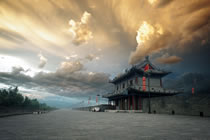 Countless ancient architecture and valuable historical relics have been preserved above and under the ground
Countless ancient architecture and valuable historical relics have been preserved above and under the ground
 Culture Qin:Museum of Qin Terra-cotta Warriors and Horses
Culture Qin:Museum of Qin Terra-cotta Warriors and Horses
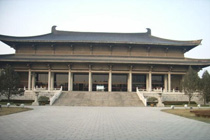 It is the first multi-functional museum complex which integrates museum, monuments and park
It is the first multi-functional museum complex which integrates museum, monuments and park
 As the symbol of the old-line Xian, Big Wild Goose Pagoda is a well-preserved ancient building and a holy place for Buddhists
As the symbol of the old-line Xian, Big Wild Goose Pagoda is a well-preserved ancient building and a holy place for Buddhists
 Tang Paradise is located in the Qujiang Resort, southeast of the Xian City, Shaanxi Province
Tang Paradise is located in the Qujiang Resort, southeast of the Xian City, Shaanxi Province
 Grand Park Hotel Xi’an
Grand Park Hotel Xi’an
 Xi'an Train Station is ranked as Class A by the nation standard with all the modern facilities
Xi'an Train Station is ranked as Class A by the nation standard with all the modern facilities
 the Chinese dumpling has a long history and is an essential part of celebra-tory meals such as those prepared for the Chinese lunar Spring Festival
the Chinese dumpling has a long history and is an essential part of celebra-tory meals such as those prepared for the Chinese lunar Spring Festival
 This is the famous Halal snacks street in ancient Xi’an City and the only professional food market that runs exclusive Halal food
This is the famous Halal snacks street in ancient Xi’an City and the only professional food market that runs exclusive Halal food
 the Grand Hongkong Restaurant has won many honors and titles
the Grand Hongkong Restaurant has won many honors and titles
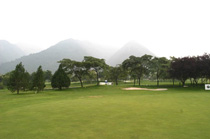 Lying at the foot of Zhongnan Mountain, Xi’an Yajian International Golf Club covers an area of over 214 acres
Lying at the foot of Zhongnan Mountain, Xi’an Yajian International Golf Club covers an area of over 214 acres
 Located just inside the South Gate, Park Qin with the unique decoration to the variety of drink specials
Located just inside the South Gate, Park Qin with the unique decoration to the variety of drink specials
 Kai Yuan Shopping Mall is regarded as one of the biggest shopping mall in Xi'an
Kai Yuan Shopping Mall is regarded as one of the biggest shopping mall in Xi'an
